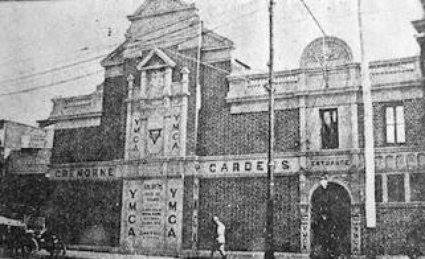https://picturesinmotion.com.au/cinema-history/NEW thank you to Ken McKay on updating the history of Cremorne Theatre
Cremorne Theatre…. the second venue in Perth to show moving pictures.
Often overlooked in the history of Perth theatres.
You may also be interested in the “Western Baptist” ISSN 1322-1582 ‘In search of Annie Oliver’, a paper by Mrs Ann Harding, read to the Baptist Historical Society on 21 April 1993.

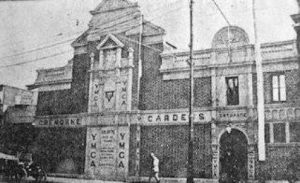
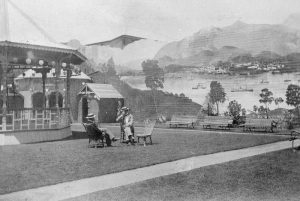
- CREMORNE GARDENS, PERTH, PICTURED IN 1896.
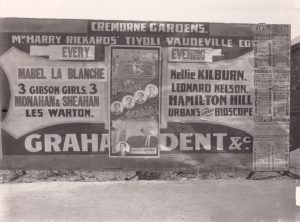
In 1920, Lamson Paragon rented the Cremorne Theatre in Murray Street, then bought the property in 1921.
“The theatre facade had the year ‘1896’ in bold relief. The historic building was converted into a compositing room, and the elaborate furnishings of the dress circle, with its red plush and gold, looked somewhat bizarre surrounded by the printing equipment. The stage itself, however, made quite a good dining-room for the employees.”
The company later moved to 37-45 Pier Street in Perth, from 1933, with extensive alterations in 1935 so that the printing plant could be relocated.
The old theatre site was then sold for £14,000.
By 1916, the Cremorne Gardens and Theatre were provided rent-free as a social service to soldiers and sailors during World War I. This had become the Cremorne Club servicing the needs of returned servicemen with free meals and free entertainment with film shows.
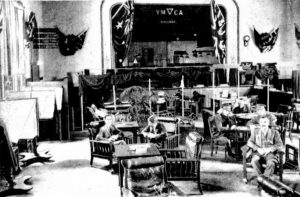
Cremorne Theatre stalls being used by returned soldiers
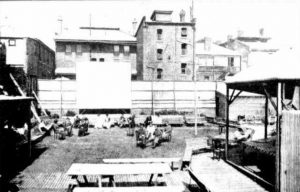
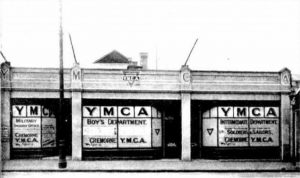
It was during this time that the Returned Sailors’ and Soldiers’ Imperial League of Australia was formed. The Soldiers Institute, located in the Government Garden’s Perth, was the League’s first permanent home. The League moved to the first ANZAC House, St George’s Terrace, in 1934 and changed its name in 1940 to Returned Sailors’, Soldiers’ and Airmen’s Imperial League of Australia which again changed its name in 1965 to Returned Services League of Australia, the RSL.Meanwhile the ABC took over their old home, which then became known as Broadcast House, until the ABC moved into its Adelaide Terrace headquarters in time for the introduction of ABC TV in 1960. The ABC vacated that site, for its present location in East Perth in 2005.
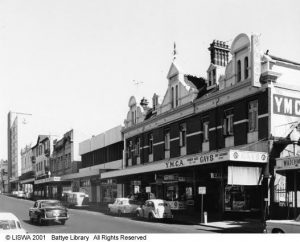
In 1920, the YMCA took over what remained of the mortgage on the Westralia Hotel, which along with the theatre and gardens was owned by a Mrs Annie Oliver. The ground floor became a lounge for older boys, with a billiard room, library, and dining room, with the upper floors becoming the hostel.
She bought the block of land in Murray Street next to the Bon Marche store, gifted it to the YMCA and in 1910, the YMCA gymnasium, a club room. billiard room and offices were opened.
Next to this was her Westralia Hotel (shown above), then her Cremorne Gardens and Theatre. The YMCA took over the hotel’s mortgage in 1920, and moved in.
Jumping back further in time….. the theatre and hotel also had a connection to Perth’s earliest electricity supply…
In 1892, the first electric street light was erected by the WA Electric Light and Power Company, in close proximity to where Annie’s hotel, gardens and theatre were to be located.
Then in 1894, The Perth Gas Company began operating the state’s first significant power station from Wellington Street, supplying 110 volts direct current. Annie’s establishment was one of the first in the city to adopt to the electric light system, a point that she advertised.
For it was in April 1895 that Mrs Annie Oliver, formerly of South Australia and Broken Hill, assumed the proprietorship of Perth’s Horse and Groom Hotel (which dated back to the earliest days of the Swan River Colony). She added extra floors and renamed it the Westralia (though it was often referred to as the Cremorne).
Her next door gardens opened on Christmas eve 1895. It featured a rotunda, palms, rockeries and a brick wall painted with woodland scenery. Spaced at intervals around the gardens were small roofed and latticed rustic kiosks, each lit up at night with coloured fairy lights, and each having a table and chairs inside for the convenience of private parties. The gardens adjoined the bungalow verandah of the hotels saloon bar. Four months later construction began on an enclosed theatre that opened on June 25th.
She was a diabetic, and died of this condition in 1921. Annie was a well liked and respected business woman who gave much to charity, but now seems to be largely forgotten.

